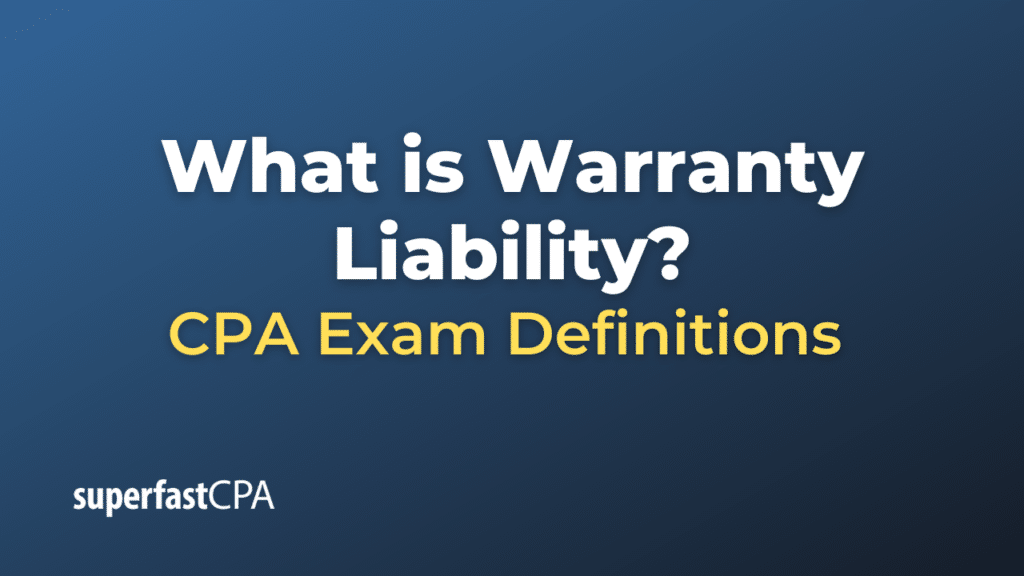Warranty Liability
Warranty liability is an accounting term that refers to a company’s obligation to repair, replace, or otherwise compensate customers for faulty or defective products during a specified warranty period. When a company sells a product with a warranty, it is making a future commitment to incur certain costs, and according to accounting principles, this future obligation should be recognized at the time of sale. Warranty liability is considered a contra-account to either cost of goods sold or operating expenses, depending on the accounting policy of the company.
How It Works
- Initial Recognition: At the time a product is sold, a company estimates the future costs it will incur to honor the warranty based on historical data or other types of analysis. This estimated amount is recorded as a warranty liability on the balance sheet.
- Journal Entry: To record the initial recognition of warranty liability, a typical journal entry would involve debiting a “Warranty Expense” account and crediting a “Warranty Liability” account.
- Adjustments for Actual Costs: As warranty claims are made and the company incurs actual costs, the warranty liability account is reduced (debited) to reflect these actual costs. Corresponding credits go to cash, inventory, or accounts payable, depending on what resources are used to fulfill the warranty.
- Periodic Reassessment: Companies generally reassess their warranty liabilities periodically and adjust the account to reflect any changes in estimates, whether due to actual experience, changes in labor or material costs, or other factors.
Journal Entries
For example, when initially recognizing the warranty:
- Debit: Warranty Expense Estimated Warranty CostsEstimated Warranty Costs
- Credit: Warranty Liability Estimated Warranty CostsEstimated Warranty Costs
When fulfilling a warranty claim:
- Debit: Warranty Liability Actual Costs IncurredActual Costs Incurred
- Credit: Inventory or Accounts Payable Parts CostsParts Costs
- Credit: Cash or Accounts Payable Labor CostsLabor Costs
Importance for Stakeholders
Both the warranty expense and the remaining warranty liability must be properly disclosed in a company’s financial statements. This information is crucial for shareholders, creditors, and other stakeholders for several reasons:
- Financial Health: A high warranty liability relative to sales or revenue might indicate quality issues with the company’s products, which could have long-term financial implications.
- Cash Flow Planning: Knowing the level of warranty liability helps in cash flow planning, as a significant part of the liability will likely be settled in cash over time.
- Risk Assessment: A changing warranty liability can be an indicator of increasing or decreasing operational risks, affecting the company’s valuation and the cost of capital.
Warranty liability, along with warranty expense, provides a more complete and accurate picture of a company’s current financial position and future obligations. It’s an important aspect of accrual accounting, helping companies match future warranty-related costs with the revenue generated from the associated product sales.
Example of Warranty Liability
Let’s consider a fictional company called “TechGiant” that sells smartphones. TechGiant offers a one-year warranty covering software and hardware malfunctions but excluding physical damages like cracks and water damage.
Background:
Based on previous data and industry benchmarks, TechGiant estimates that around 4% of the phones sold will require some form of warranty service, with an average cost of $50 per service.
Scenario:
- Initial Sales: TechGiant sells 1,000 smartphones in October, with each phone priced at $700, generating $700,000 in total revenue.
- Warranty Expense Estimate:
- 1,000 phones x 4% (estimated returns) = 40 phones
- 40 phones x $50 (estimated service cost) = $2,000
Accounting Entries:
At the Time of Sales in October:
- Recognize Sales Revenue and Accounts Receivable:
- Debit: Accounts Receivable $700,000 (1,000 phones x $700)
- Credit: Sales Revenue $700,000
- Recognize Warranty Expense and Liability:
- Debit: Warranty Expense $2,000
- Credit: Warranty Liability $2,000
During November, When Actual Warranty Costs Are Incurred:
Let’s assume 30 phones are actually returned for warranty service in November, with an average repair cost of $48, totaling $1,440.
- Adjust Warranty Liability for Actual Costs:
- Debit: Warranty Liability $1,440 (30 phones x $48)
- Credit: Inventory or Accounts Payable $1,440
Year-End Adjustments:
At the end of the year, TechGiant reviews its warranty liability and finds the average cost of repair has actually been $48 instead of the $50 initially estimated.
- New Warranty Liability Estimate:
- Remaining phones under warranty: 1,000 – 30 = 970 phones
- 970 phones x 4% (estimated returns) = 38.8 (approximately 39 phones)
- 39 phones x $48 (new estimated cost per repair) = $1,872
- Adjust Warranty Liability:
- Debit: Warranty Expense $128 ($2,000 old estimate – $1,872 new estimate)
- Credit: Warranty Liability $128
This example shows how a warranty liability is initially recognized based on an estimated warranty expense. The liability is then adjusted as actual warranty services are provided. Finally, at year-end or another suitable period, the company reassesses and adjusts its warranty liability based on actual experience and updated estimates. This process ensures that the company’s financial statements accurately reflect its current obligations and future costs.













